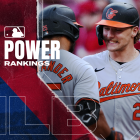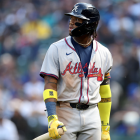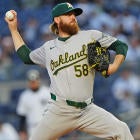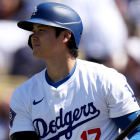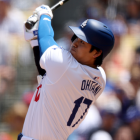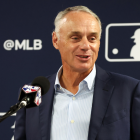Each is among the greatest players in baseball history -- Barry Bonds is the all-time home run leader who has to his credit a career WAR of 162.8 (!) and seven MVP awards, while Roger Clemens won 354 games while authoring a WAR of 139.0 and winning seven Cy Youngs. Each has been on the Baseball Writers' Association of America (BBWAA) Hall of Fame ballot for six years without garnering the support necessary for Hall of Fame induction, and each has suffered such a fate because of strong allegations of performance-enhancing drug use.
As though those weren't similarities enough, here's how Bonds' and Clemens' BBWAA support has tracked over those six years ...
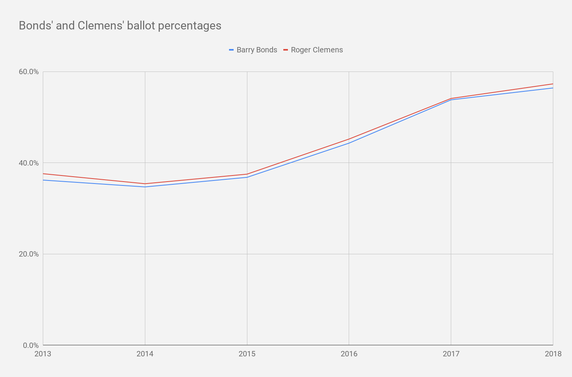
Since Bonds hit the ballot in 2013, he's put up ballot percentages of 36.2, 34.7, 36.8, 44.3, 53.8, and 56.4. Clemens, meantime, has received ballot percentages over that same span of 37.6, 35.4, 37.5, 45.2, 54.1, and 57.3. While it's bizarre in the extreme that a handful of voters have cast their ballots for Clemens but not Bonds, these figures are remarkably similar, as are the trendlines. The heart of the matter is where they go from here.
Starting with the 2014 BBWAA ballot, candidates were allowed 10 years on the ballot rather than the old cutoff of 15 years, which had been the standard since 1962. While a handful of candidates were grandfathered in under the old rules, Bonds and Clemens -- coming off their ballot debut -- were not. That means, counting the 2019 results, Bonds and Clemens have four rounds of voting to make it in. If they don't, then their only hope for induction will be when an Era Committee takes up their cause at some point in the distant future.
By way of reminder, a candidate must be named on at least 75 percent of ballots in order to earn election. Bonds and Clemens have received majority support in each of the last two cycles, which is an important benchmark, but they're running out of time. Over at Ryan Thibodaux's excellent and necessary Hall of Fame Ballot Tracker, we find that Bonds and Clemens right now are being named on more than 70 percent of publicly disclosed ballots. That's tantalizingly close to the figure they need, obviously, but recent history strongly suggests they'll see a significant decline in support once the tally becomes official. That said, additional forward momentum seems likely.
So what does history say about this? Let's assume Bonds and Clemens don't make it this year and the next. That means they'll have the ninth and 10th years remaining to clear that 75 percent threshold. Let's assume that's the case and see what history teaches us about the relevant trends.
In the annals of BBWAA Hall of Fame voting, eight players -- Andre Dawson (2010), Goose Gossage (2008), Tony Perez (2000), Joe Medwick (1968), Hank Greenberg (1956), Bill Dickey (1954), Dizzy Dean (1953), and Al Simmons (1953) -- earned election on the ninth ballot. Additionally, four players -- Don Drysdale (1984), Lou Boudreau (1970), Joe Cronin (1956), and Ted Lyons (1955) -- made it in on the tenth ballot. Starting with year seven (the current year on the ballot for Bonds and Clemens), here are the average ballot percentages for those players who earned election in year nine and year 10 ...
Group/Year on ballot | Ballot 5%, year 7 | Ballot %, year 8 | Ballot %, year 9 | Ballot %, year 10 |
Inducted in ninth year (Dawson, et al.) | 60.6 | 67.0 | 80.7 | x |
Inducted in 10th year (Drysdale, et al.) | 44.7 | 48.5 | 62.5 | 80.3 |
If trends hold and the duo in question sees a drop-off among non-public ballots in line with last year's levels, then Bonds will wind up around 67.3 percent for 2019 (i.e., year seven) with Clemens at 68.3 percent in year seven of their respective candidacies. As you can see above, this means they'll compare quite favorably to both the year-nine group and the year-10 group. That's good news for Bonds and Clemens, as their forward momentum stalled a bit last year. Even if they fall a bit short of that high-60s projection noted above, they're still going to be in good shape moving forward. Likely, they'll need to gain 10 percent or less and have three more ballots to get there.
As well, the candidates in those year nine and year 10 buckets never made it to their final year on the ballot and thus didn't get to enjoy the final-year boost that's almost a historical imperative for candidates that remain on the ballot for the maximum number of years. If Bonds and Clemens don't make it in year eight or year nine, then they can likely count on a bump in year 10.
The influx of new voters is also working in their favor. Over the years, the BBWAA has become more welcoming of web-based baseball writers, and that trend continues. After being in the BBWAA for 10 years, a member gains a Hall of Fame vote, and that post-newspaper generation of voters continues to trickle into the Hall of Fame voting body. For a variety of reasons, this newer generation is much more supportive of Bonds' and Clemens' cases than many of their predecessors. Thanks once again to Thibodaux's ballot tracker, we have data on how first-time voters have treated Bonds and Clemens over their years of eligibility. Starting with the 2017 and counting the results to date, Bonds and Clemens have been comfortably north of 80 percent support among first-time voters. They figure to continue making up ground as more voters hit the rolls in 2020 and, if necessary, 2021 and 2022.
Lump all these considerations together -- Bonds' and Clemens' trends compared to those similar candidate populations, the possibility of a last-year jump, and the accommodating stance of those new voters -- and Bonds and Clemens look like they're going to make it to Cooperstown via the traditional route. Maybe it comes down to the last year, but it's going to happen. Not every voter and invested observer will be pleased, just as some will see the honor as woefully belated. Whatever your stance, get used to the idea of Bonds and Clemens being Hall of Famers.














